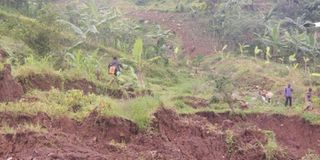Uganda needs long-term actions on climate change

Effects of climate change such as extreme weather and landslides are felt most in agriculture which most of the population in Uganda is dependent on. FILE PHOTO
What you need to know:
Later this month, more than 100 countries will meet in Paris, France for a UN summit on climate change. Uganda has made steps to address the issue but there is more to be done. Ann Natukunda spoke to Tracy Kajumba, the national programme coordinator, Africa Climate Change Resilience Alliance (ACCRA).
A number of developing countries have set out their plans for low carbon development in-country. What is the case for Uganda?
As much as the plans focus on mitigation, Uganda’s priority is on adaptation. It’s not that we are not talking about mitigation, but the main thing is adaptation—focusing on agriculture, water, livestock and others, making sure that these sectors are strengthened to reduce vulnerabilities. Regarding mitigation, it is mostly on forestry, wetlands, transport and others.
What are the constraints in implementing the plan?
First of all, the institutional capacities: Do we have the capacity to address these issues? There is a problem of short-term financing, we get funding for projects. Adaptation cannot happen in a [short time], it is a process. We need to focus on long-term programming to achieve what we are committing to do.
There are issues of institutional coordination. Climate change is cross-cutting. There’s a lot of work around coordination to ensure that all issues are addressed. But it’s a good step for Uganda to have worked on its plan. It will be a catalyst for leveraging financing.
What should we expect from the Paris Agreement? What are the priorities?
Uganda developed its Napa (National Adaptation Programmes of Action) in 2007. We didn’t have funds for implementation until Danish Embassy provided funds in 2011. This was only piloted for one year in five districts, out of the more than 100 in the country.
We need long-term programming and financing. Short-term programmes do not address adaptation. There is need to lobby for long-term adaptation financing, where we can test technologies, innovations, attitude changes.
Emphasis has been on supporting climate-smart agriculture because over 85 per cent of our population depends on agriculture.
Are there possibilities for local funding?
Uganda can find local financing. It may not be enough but it can do something. Internally, there is something we can do to support these adaptation activities. We need to change the mindsets; we need to build capacity, with or without the finances.
What about loss and damage? Is it an important issue for Uganda?
Loss and damage is an important issue. For example, Office of the Prime Minister conducted a study in 2012 on losses [from] droughts and floods. It was estimated that $470m was lost in food and cash crops and livestock from the 2010-2011 drought. There was also the 2008 drought, the loss was $47m (according to Nema).
Also, in terms of infrastructure, annual damage, including building costs, is estimated at $20m-$130m a year (depending on how loss of life is also valued). If not addressed and the weather events increase, the losses will rise to $39m-$234m by 2025 and to $189m-$838m by 2050.
Those are just examples of the magnitude of the losses. We know the disasters; landslides in Bududa, eastern Uganda, where lives and property were lost. How do you cost lives? The floods in Kasese, western Uganda that destroyed a hospital, homes, property, crops etc. The floods in Teso, which destroyed infrastructure; the Karamoja drought where animals die in huge numbers.
If a loss-and-damage mechanism is included in the agreement, how do you think it will be funded?
That is even hard to answer because we are struggling with even bigger issues—priority issues as a country and the funding. When you look at the costed implementation strategy for the National Climate Change Policy, we expect to raise 70 per cent of the budget from international donors. As a country we are contributing only 30%. So, if you add loss and damage, I am not sure we would be able find that kind of funding. But, like I said before, by strengthening systems, we can contribute to reduction of loss-and-damage.
Have we looked at the potential for private finance to address climate change generally, not just about loss and damage?
We have somehow not looked at the role of private sector yet climate change impacts on them as well. They may even have the resources to contribute. For instance, we have tea companies; when you look at studies done, most of them are going to be affected in the long term, and they need to be part of the action around climate change. There are also telecom companies who would contribute in disseminating weather information.
What can developing countries do about carbon emissions?
Uganda has committed to reduce 20 per cent of the emissions in the country by 2030.
But we also need to table the actions that can be supported by developed countries, because we don’t have the funds to do all that.
This interview is part of a series commissioned by International Institute for Environment and Development (IIED) ahead of the COP21 summit in Paris, France.




